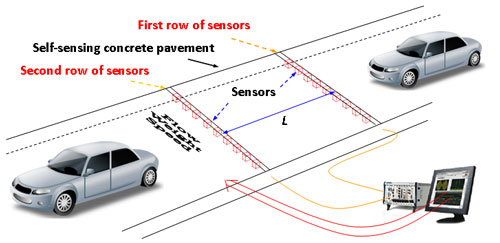| Posted: Oct 09, 2009 | |
Traffic monitoring with a self-sensing concrete nanotechnology road surface |
|
| (Nanowerk Spotlight) Many communities in the U.S. and Europe have started to integrate intelligent transport systems (ITS) into their transportation system infrastructure to help monitor and manage traffic flow and reduce congestion. These systems also provide transportation professionals with the tools to collect, analyze, and archive data that helps assess the performance of these systems. One important part of these ITS are traffic flow sensors that provide real-time information for services and applications like traffic signal control, toll road metering, or onboard navigation systems. Accuracy and reliability of traffic flow sensors has a significant impact on the usefulness of ITS. | |
| Researchers have now developed a self-sensing nanotechnology composite material for traffic monitoring by using piezoresistive multi-walled carbon nanotubes (CNTs) as an admixture. In experiments, they studied the response of the piezoresistive properties of this composite to compressive stress and they investigated with vehicular loading experiments the feasibility of using self-sensing CNT/cement composite for traffic monitoring. | |
| "Our experimental results indicate that there are good corresponding relationships between compressive stress and the electrical resistance of the self-sensing CNT/cement composite," Xun Yu tells Nanowerk. "Our self-sensing CNT/cement composite also presented remarkable responses to vehicular loadings. These findings indicate that this self-sensing nanocomposite cement has great potential for traffic monitoring use such as in vehicle detection, weigh-in-motion measurement and vehicle speed detection." | |
| Yu, an assistant professor in the Department of Mechanical & Industrial Engineering at the University of Minnesota, Duluth, together with his collaborators has reported these findings in the October 7, 2009 online issue of Nanotechnology ("A self-sensing carbon nanotube/cement composite for traffic monitoring"). | |
| An interesting aspect of this work is that, from the eventual traffic application's point of view, the pavement itself would become the traffic detection, thus eliminating the need for separate traffic flow detection sensors. | |
 |
|
| Illustration of self-sensing concrete pavement for traffic flow detection. (Reprinted with permission from IOP Publishing) | |
| Yu explains that previously, some research work has been carried out on the use of carbon fibers for the fabrication of piezoresistive cement composite materials. However, the piezoresistive properties of carbon fibers is irreversible as their structure will break under repeated stress. On the other side, the carbon nanotubes used here are much stronger and have reversible piezoresistive properties. | |
| The way this self-sensing cement works is that, when subjected to stress/strain, the CNTs in the cement will show electrical properties that change with the level of stress/strain, expressing a linear and reversible piezoresistive response. The changes in electrical resistance, depending on the load exerted on the cement, can then be measured with a two-electrode method using a digital multimeter. | |
| To fully utilize the piezoresistive properties of CNTs, the nanotubes need to be well dispersed in the cement matrix. Yu's team uses surfactant sodium dodecylbenzene sulfonate (NaDDBS) to assist the dispersion and that appears to be working quite well. | |
| "Our findings indicate that the self-sensing CNT/cement composite can detect traffic flow and even possibly identify different vehicular loadings (weigh-in-motion detection)," says Yu. "The vehicle weight measurement is needed to prevent damage to highways due to overweight vehicles, such as heavy trucks. It is currently conducted in weighing stations off the highway while the vehicle is stationary. The monitoring of vehicle weights can be more convenient and effective if the weighing is performed on the highway while the vehicle is moving normally. In this way, traffic is not affected and time is saved." | |
| Currently, traffic flow sensors use a range of detection technologies – microwave radars, infrared sensors, video image processors, and inductive loop detectors. The latter one can accurately measure occupancy, vehicle speed, and gaps. However, there are several limitations with inductive loop detectors: they need pavement cutting for installation, require lane closure for maintenance, and decrease the pavement life due to unfavorable compatibility with pavement in the highway. Self-sensing cement could replace existing road surfaces during regular re-surfacing work and would not need any maintenance. | |
| Apart from detecting traffic flow and monitor weight loads, the self-sensing capability of the nanocomposite to detect stress levels could also find applications in monitoring the health of civil structures such as bridges. Deformation in the structure would register as a change in the electrical resistance and could be remotely monitored. | |
| There are still some issues that need to be examined before any real-world applications could occur. An important one is to find the influence of environmental parameters, such as temperature and moisture, on the composite's sensing functions. | |
 By
Michael
Berger
– Michael is author of three books by the Royal Society of Chemistry:
Nano-Society: Pushing the Boundaries of Technology,
Nanotechnology: The Future is Tiny, and
Nanoengineering: The Skills and Tools Making Technology Invisible
Copyright ©
Nanowerk LLC
By
Michael
Berger
– Michael is author of three books by the Royal Society of Chemistry:
Nano-Society: Pushing the Boundaries of Technology,
Nanotechnology: The Future is Tiny, and
Nanoengineering: The Skills and Tools Making Technology Invisible
Copyright ©
Nanowerk LLC
|
|
|
Become a Spotlight guest author! Join our large and growing group of guest contributors. Have you just published a scientific paper or have other exciting developments to share with the nanotechnology community? Here is how to publish on nanowerk.com. |
|
